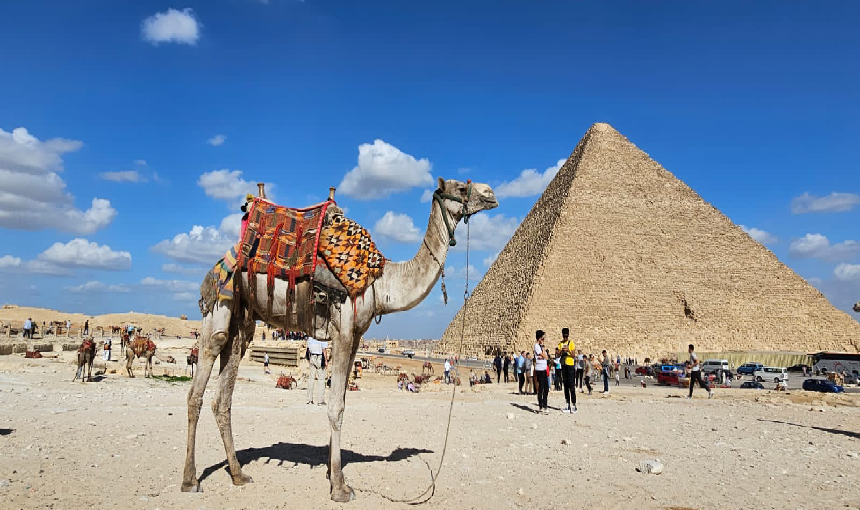The Pyramids of Egypt stand as a testament to the ingenuity and ambition of one of the world’s oldest civilizations. These ancient structures, primarily built during the Old and Middle Kingdom periods, have fascinated historians, archaeologists, and tourists for centuries. This article delves into the history, construction techniques, and significance of the Egyptian pyramids, with a focus on their enduring allure.
A Glimpse into Ancient Egypt
Ancient Egypt, with its rich cultural heritage and advanced civilization, thrived along the banks of the Nile River. The civilization’s monumental achievements in architecture, art, and science have left an indelible mark on history. Among these achievements, the pyramids stand out as the most iconic symbols of ancient Egyptian prowess.
The Purpose of the Pyramids
The pyramids were primarily constructed as tombs for pharaohs and high-ranking officials. The Egyptians believed in an afterlife where the deceased would need their physical bodies and earthly possessions. Therefore, they built elaborate tombs to ensure the safe passage and preservation of their rulers’ remains. The pyramids were part of larger complexes that included temples, causeways, and smaller tombs for nobles.
The Great Pyramid of Giza: A Marvel of Engineering
The most famous and largest of all the pyramids is the Great Pyramid of Giza, built for Pharaoh Khufu (also known as Cheops). This colossal structure, originally standing at 146.6 meters (481 feet), was the tallest man-made structure in the world for over 3,800 years. The precision and skill involved in its construction have baffled scholars and engineers alike.
Construction Techniques:
- Material: The core of the Great Pyramid is made of limestone blocks, while the outer casing was originally covered with smooth Tura limestone. The interior includes granite blocks used in the King’s Chamber.
- Labor Force: It is estimated that thousands of skilled laborers, not slaves as often misconceived, worked for decades to construct the pyramid. These workers lived in nearby temporary settlements and were well-fed and cared for.
- Tools and Methods: The exact methods used to build the pyramids remain a subject of debate. However, it is believed that ramps, levers, and sledges were employed to transport and position the massive stones. Recent theories suggest that a combination of straight and spiral ramps might have been used.
Other Notable Pyramids
While the Great Pyramid is the most famous, Egypt is home to over 100 pyramids. Some other significant ones include:
- Pyramid of Khafre: Located next to the Great Pyramid, this pyramid appears taller due to its construction on higher ground. It also includes the famous Great Sphinx of Giza, a guardian statue with the body of a lion and the head of a pharaoh.
- Pyramid of Menkaure: The smallest of the three main pyramids at Giza, it is still an impressive structure with a base length of 108.5 meters (356 feet).
- Step Pyramid of Djoser: Located in Saqqara, this pyramid is considered the earliest colossal stone building in Egypt. Designed by the architect Imhotep, it marked the transition from traditional mastaba tombs to pyramid structures.
- Bent Pyramid: Located in Dahshur, this unique pyramid is named for its bent appearance. It provides insight into the architectural experimentation that preceded the smooth-sided pyramids.
The Cultural and Religious Significance
The pyramids were not merely tombs but also had profound religious significance. They were believed to be the pharaohs’ gateway to the afterlife, where they would become gods. The pyramid’s shape, pointing towards the sky, symbolized the rays of the sun, connecting the earthly realm with the divine.
The alignment of the pyramids with astronomical bodies also indicates the Egyptians’ advanced understanding of astronomy. For instance, the sides of the Great Pyramid are closely aligned with the cardinal points of the compass, and its internal passages align with specific stars.
Preservation and Tourism
Over millennia, the pyramids have withstood natural and human-made challenges, including earthquakes, looting, and vandalism. Efforts to preserve these ancient wonders continue today, with modern technology aiding in their conservation.
The pyramids of Egypt attract millions of tourists annually, contributing significantly to the country’s economy. Visitors marvel at the grandeur and mystery of these ancient structures, gaining a deeper appreciation for Egypt’s rich heritage.
The Pyramids of Egypt are more than just ancient tombs; they are enduring symbols of human ingenuity, ambition, and spiritual belief. These architectural marvels continue to captivate and inspire, standing as a bridge between the ancient past and the present. As we uncover more about these timeless structures, they remind us of the remarkable achievements of the ancient Egyptians and their lasting legacy on human civilization.
Whether you’re a history enthusiast, an aspiring archaeologist, or a curious traveler, the pyramids offer a fascinating glimpse into a world that continues to intrigue and inspire.
Don't miss checking our other Egypt Nile Cruises




